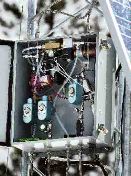forum
library
tutorial
contact

Steroids for Snow
by Ken DeyIdaho Statesman, February 15, 2004
|
the film forum library tutorial contact |

|
Steroids for Snowby Ken DeyIdaho Statesman, February 15, 2004 |
Cloud seeding science is still disputed, but Idaho’s four-year drought makes it a gamble many are taking
 Gary Riley has lost a lot of sleep chasing winter storm clouds. Riley, a senior meteorologist with Idaho Power Co., is in charge of the company´s new cloud seeding program launched this year in the Payette River basin.
Gary Riley has lost a lot of sleep chasing winter storm clouds. Riley, a senior meteorologist with Idaho Power Co., is in charge of the company´s new cloud seeding program launched this year in the Payette River basin.
He watches the forecasts and makes the decision on when the company is ready to start seeding a storm cloud with chemicals in hopes of bringing more snow to the mountains, which in turn means more water to the company´s reservoirs this spring.
He´s often forced to call out his seven-member team with as little as two hours´ notice to fire up the remote-controlled cloud seeding generators or get the company´s cloud seeding plane in the air.
“You have to work with Mother Nature. Whenever she goes, you go — and it´s usually weekends or nights,” Riley said.
You could call Idaho Power´s cloud seeding program steroids for snowmaking.
Cloud seeding advocates say the chemical boost they give Mother Nature during the winter can lead to more snow in the mountains.
With Idaho in its fourth year of drought, the more than half-century-old method of coaxing more snow from winter storms is becoming a popular avenue for Idaho´s water users — despite ongoing questions about whether or not it works.
This winter several irrigation districts, eight counties and even Idaho Power are investing millions of dollars in cloud seeding programs across the state.
Idaho Power is in its first year of a three-year program in hopes of increasing the snowpack by at least 10 percent.
Why try cloud seeding?
 The reason? To save money, Idaho Power needs to send more water through its hydropower dams and avoid buying electricity on the wholesale market. But during the last four years of drought, the state´s largest electric utility has lost a third and sometimes close to half of its generating capacity at its hydropower dams.
The reason? To save money, Idaho Power needs to send more water through its hydropower dams and avoid buying electricity on the wholesale market. But during the last four years of drought, the state´s largest electric utility has lost a third and sometimes close to half of its generating capacity at its hydropower dams.
In a normal water year, the utility can generate almost 60 percent of its power from its dams, but in 2001 at the height of the drought the company only generated 34 percent of its power from dams.
“The key to low-cost power is what the snowpack is,” says Roger Fuhrman, director of water management for Idaho Power.
Fuhrman said the company has invested just more than $1 million in the first year of what will become a three-year pilot program.
This isn´t the company´s first attempt at cloud seeding. A program in the mid-1990s was started, but quickly shelved in the winter of 1996 when the natural snowpack was well above normal.
Crisis spurred interest
The company´s renewed interest in cloud seeding began during the energy crisis of 2000 and 2001. In the midst of an ongoing drought, the utility wasn´t able to generate enough power through its hydro dams, so they had to buy power from the wholesale market at grossly inflated prices — a move that led to record rate increases for customers.
Before embarking on cloud seeding, Fuhrman said the company had to satisfy itself that the process really worked and that the benefits of cloud seeding would outweigh the costs.
The costs for the company´s cloud seeding could ultimately be borne by ratepayers.
With most of the capital costs already incurred, Fuhrman estimates the costs for the next two years could be about $500,000 a year.
Gene Fadness, a spokesman for the Idaho Public Utilities Commission, said in order to recoup the costs from customers the company will have to provide proof that the expenses were justified.
If Idaho Power is successful in obtaining a 10 percent increase in snowpack through cloud seeding, the company estimates it would allow for the generation of an additional 80,000 megawatt hours of electricity, which would provide power for about 6,000 homes for a year.
Does it really work?
A report last fall released by the National Academy of Sciences suggested that more study is needed to answer this question.
The report said there is “ample evidence” that cloud seeding with a chemical agent could modify a cloud´s development and precipitation, but suggested that the science behind cloud seeding is “too weak” to prove that it actually produces results.
Cloud seeding advocates dispute the report, saying the methods they use are proven and scientifically sound and many cloud seeding projects have increased snowfall.
“We´re not the snake oil salesman and the rainmakers of the ´30s,” says Idaho Power´s Riley, who has more than 20 years´ experience seeding clouds, including work with many of the larger California utilities that have been cloud seeding for years.
Riley and others say they welcome the call for more study on cloud seeding, something that has fallen off dramatically in the last few decades.
In the late 1970s the United States invested more than $20 million a year in weather-modification research, but now spends less than $500,000 annually. President Bush´s new budget has no new money for cloud-seeding research.
“I´ll be the first to say that we don´t know all the answers about clouds, but I couldn´t do this if I didn´t think we were having some positive effects,” said Don Griffith with North American Weather Consultants, a private cloud seeding firm in Sandy, Utah.
Griffith´s company has been cloud seeding since the 1950s. It´s responsible for many large cloud seeding projects in the West, including this year´s cloud seeding above Lucky Peak reservoir for the Boise Project Board of Control, a private board that oversees the use of irrigation water from the Boise River.
The science of rainmaking
 Griffith said the concept behind cloud seeding hasn´t changed much since it was first introduced in the 1940s.
Griffith said the concept behind cloud seeding hasn´t changed much since it was first introduced in the 1940s.
A chemical agent, usually silver iodide, is introduced into a cloud in an attempt to stimulate snowfall. Griffith says snowfall from clouds during the winter is variable because there aren´t enough natural ice-creating stimuli to convert super-cooled water droplets into ice crystals, which can eventually become snow.
When silver iodide is introduced into the water droplets, it helps them form into ice crystals. Those crystals then attract other droplets until they have enough weight to fall from the sky as snowflakes.
Griffith said a case study of the Boise Project during cloud seeding in the winters of 1993 through 1996 found that the snow water content increased by an average of 12 percent, giving an additional 2.5 inches of water in the spring.
The biggest misconception about cloud seeding is that it can create snow out of cloudless sky.
“Mother Nature has to give you something to work with,” Idaho Power´s Riley said.
As its name implies, cloud seeding needs clouds. Riley said cloud seeding is only possible when a number of factors come together. First there has to be a winter storm system already predicting snow; the temperature also has to be low enough to create snow, because Idaho´s cloud seeders are not after rain. They need snow to build the snowpack, so the water will be ready to run off the mountains and into the rivers in the spring.
When conditions are right, Idaho Power introduces the silver iodide from remote-controlled ground based generators that distribute the chemical into the airstream to carry it to the storm system. The company also seeds clouds by depositing the silver iodide in the cloud from an airplane.
If no winter storms arrive, cloud seeding isn´t possible.
Testing the theory
 Most cloud seeding is deemed successful or not depending on how much the snowpack increases. Measuring that snowpack is done in a process called “target and control” that compares snow measurement sites in the cloud seeding area with snow measurement sites outside of the area, and determining a snowpack percentage increase or decrease.
Most cloud seeding is deemed successful or not depending on how much the snowpack increases. Measuring that snowpack is done in a process called “target and control” that compares snow measurement sites in the cloud seeding area with snow measurement sites outside of the area, and determining a snowpack percentage increase or decrease.
That method is far from precise, so Idaho Power is taking things one step further by including in its cloud seeding program an inert chemical tracer in conjunction with the silver iodide.
Idaho Power has hired Desert Research Institute, part of University of Nevada at Reno, to take snow samples in the cloud seeding areas. From those samples the company hopes to find traces of the silver iodide and the inert tracer to determine what percentage of the sample resulted from cloud seeding.
Fuhrman said some early sampling has found significant amounts of silver iodide in the snowpack, but the company is committed to shutting the program down if the long-term research doesn´t prove it´s successful.
Not the perfect cure
In the 1930s, so-called rainmakers descended upon communities claiming they could bring rain and turn around the droughts plaguing much of America.
But cloud seeders make no such claim.
Todd Adams, manger of Utah´s state-run cloud seeding program, said cloud seeding efforts in the state have consistently increased snowfall by an average of 10 to 15 percent in many areas.
But he said those increases have to be put into context.
A 10 percent increase of snowfall in a drought-stricken area may only increase water flow that year from 30 percent to 33 percent of normal.
“That´s not enough to get you out of a drought, but it helps keep soil moisture higher and possibly keep the reservoirs that much higher, so the benefits of doing it are quite high,” Adams said.
Utah officials are believers
The state has had an ongoing cloud seeding program since the 1970s.
This year the state will spend about $150,000 to help fund cloud seeding programs.
In the year 2000, Adams said, the state calculated that the increased water cost about $1 per acre foot, which Adams said is quite reasonable.
Buying water from other water users can range anywhere from $3 to $60 an acre foot. Dennis Lopez, a spokesman for Idaho Power, said during the energy crisis the company tried to buy water at $60 an acre foot, but couldn´t find anyone willing to sell.
Griffith of North American Weather Consultants says too many people make the mistake and wait until the drought situation is desperate before considering cloud seeding.
“You shouldn´t look at cloud seeding as a drought relief tool to save our bacon because it´s probably not going to happen,” he said. “There are less opportunities in a drought because there are less clouds, and we´re not going to create clouds.”
learn more on topics covered in the film
see the video
read the script
learn the songs
discussion forum
